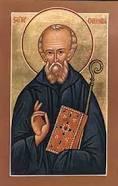
Feast day: 9 June
St Columba or Colm Cille (meaning church dove), was born on 7 December 521. His parents were Fedlimid and Eithne of Cenel Conaill in Gartan, near Lough Gartan in modern Co. Donegal. He was a great-great-grandson of Niall of the Nine Hostages. It is not certain whether Columba was his birth name; it could have been Crimthann, meaning "fox". He entered the monastic school of Movilla at Newtownard under St Finnian, when he was about twenty and a deacon; he finished his training at Movilla and travelled south to Leinster where he became a pupil of Gennan, an ancient bard. He subsequently entered the monastery of Clonard which was governed by Finnian. There he absorbed the traditions of the Welsh church, as Finnian had trained in the schools of St David; Clonard was a centre of Latin learning and Christian theology. There were about 3,000 students at Clonard. Columba was counted as one of the twelve students who studied under Finnian, known as the "Twelve Apostles". At Clonard Columba became a monk and a priest. He later returned to Ulster.
Columba was described as a striking figure of a man with a loud, melodious voice that could be heard from one hilltop to another. It is said that he planned a pilgrimage to Rome but only got as far as Tours. There he visited the tomb of St Martin and obtained a copy of the gospel which had lain with the saint for over one hundred years.
Columba seems to have got involved in some disputes. One was the famous incident whether he made a copy of a psalter belonging to St Finnian. He wanted to keep the psalter but Finnian disputed his claim. This led to an armed conflict where many were killed. Columba got involved in another battle over right of sanctuary and the killing of his kinsman. Again many were killed. In reparation Columba went into exile.
In 563 he travelled to Scotland with twelve companions, in a wicker currach covered in leather. He landed first on the Kintyre peninsula but since it was in sight of Ireland he moved further north to Iona. The island was made over to him by his kinsman Conall Mac Comgaill, king of Dal Riata. He was hardly in foreign territory as the Irish had been colonising the west coast of Scotland for a couple of centuries.
Columba worked hard as a missionary, wrote about three hundred books and founded several churches in the Hebrides. He is even said to have been responsible for driving an unidentified animal into Loch Ness! He returned to Ireland only once, to found a monastery at Durrow. He died in Iona in 597. His relics were divided between Scotland and Ireland; it is said that the Irish ones are buried in Downpatrick.
The main source of information on Columba's life is the Vita Columbae, written in the style of a medieval hagiographer by Adomnan, ninth abbot of Iona, about a century after Columba's death. Columba appears like a hero in Celtic mythology. There are stories of his visions, his prophecies and his miracles. Though Adomnan’s accounts conflict with other sources, it is a document that gives valuable information about life in early medieval Scotland and the development of monasticism there.
Columba is the patron saint of the city of Derry where he founded a monastery. He is credited with the revitalisation of monasticism in Scotland.
St Columba pray for us.